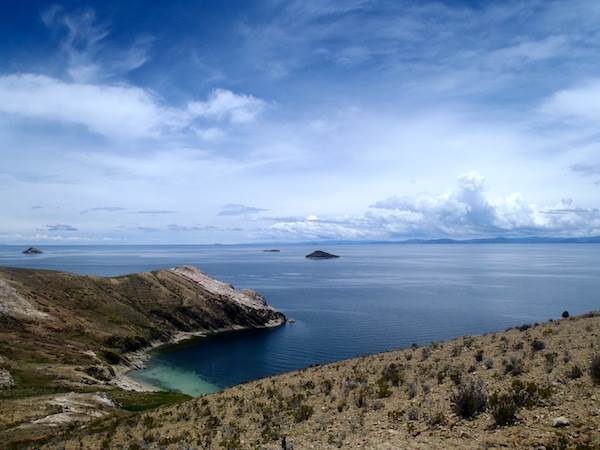Isla del Sol, Island of the Sun in English, is considered the very birthplace of the world, or the birth of the Sun God according to the Incas. It is here, according to the myths, that the God Viracocha, creator of the universe, stepped out of the waters of Lake Titicaca and created the sun. Even today, Isla del Sol is covered in Inca ruins and filled with myth and legend. Whether you are coming from Peru or leaving Bolivia travel to Isla del Sol and it’s smaller twin, Isla de la Luna, for an incredible experience.

Isla del Sol – North
Most people opt for a full day tour of the island which includes a 3-hour boat ride to the Northern part of the island and a 2-hour boat ride back from the Southern tip.
In the North, you will be dropped off at the town of Challapampa. You will need to pay an additional 5 Bolivian Sols for entrance to the archaeological ruins, but you can also use your ticket to visit the Museum of Gold in the center of Challapampa. The Gold Museum is small and a little rundown, but it is filled with a few interesting artifacts that have been pulled up from the bottom of Lake Titicaca. Myths say that thousands of pounds of gold, precious metals, and sacrificed animals were thrown into the lake in tribute to the Inca creation gods.
After the museum, leave town on the old Inca road, heading north to the main archaeological ruins. The hike to the very northern tip of the island takes 45 minutes to over an hour, depending on how bad your altitude sickness is. While the hike itself isn’t too demanding, the high altitude and strong sun will make it feel much worse than it really is. Be sure to wear lots of sun screen and layers. You’ll need a sweater on the cold morning boat ride but by the time you are done hiking, you’ll forget that you are in chilly, high mountain Bolivia.
At the north point of the island, look for a guide. You’ll need one if you hope to understand what all the ruins and rocks mean and what they were originally for. Some of the main sites are:
The Inca Table
This large stone table was were sacrifices to the Inca gods happened. The Inca weren’t known for human sacrifice and in all likelihood this table was used mainly for animal sacrifices.
The Sacred Rock
Tour guides refer to this as the Rock of the Puma but it’s pretty hard to make out the Puma without help. This was the center of the Inca creation myth and one of the most sacred places in all of the Inca empire.
The Chincana Labyrinth
Just a bit past the Sacred Rock is a maze of Inca ruins. These buildings are believed to have housed the many people caring for the Inca temple and visiting the Isla del Sol for worship. There is a small spring near the center of the labyrinth that is suppose to bring health to all that drink it.
Isla del Sol – South
If you are feeling up to it, and not too altitude sick, you can opt to walk along the Inca road from the ruins in the north all the way down to the southern port of the island and the small town of Yumani. The walk will take a few hours and it is recommended not to walk the road at night.
On the other hand, you can opt to catch a boat to the southern part of the island and this is often included in your day tour price. Either way, once you are at the southern end of Isla del Sol, there are a few more Inca sites to see.
The Inca Steps
These steps climb down the steep southern slopes of Isla del Sol and all the way to the port. They are very difficult to climb but if you made the trek all the way from the northern area of the island, they are a welcomed end of the journey down to the waiting boats in the port.
The Fountain of the Inca
On the way down, or up, the Inca Steps, be sure to stop at the Fountain of the Inca. This was at one point though to be the possible Fountain of Youth by the Spanish and it is still used as the water source for the villagers in Yumani.
Isla del Sol is a great place to visit during your Bolivia travels if you like Inca ruins, myths, or are just looking for some amazing views of Lake Titicaca. The nearby Isla de la Luna is known to have even better preserved ruins, but is not always open to the public, especially in low season.


